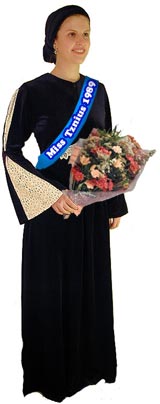Because it’s impossible to write enough stories on Hasidic Jews and sexuality, Nextbook has an article on dressing modestly in Crown Heights. The neighborhood in Brooklyn is home to the Chabad-Lubavitch sect of Hasidic Jews, although, because of their commitment to outreach, they’re known in press circles by their colloquial name of The Hasidic Jews to Turn To Whenever We Need A Story About How Weird Hasidic Jews Are.
 And, no matter what else I say about the Hasidim in my neighborhood, they never fail to disappoint. When I read the article’s lede — “An outsider visiting Crown Heights might be forgiven for thinking that the women in the ultra-Orthodox neighborhood represent the height of modesty” — I was baffled. After all, shuttling between Boro Park and Williamsburg, where the most common accoutrement for women is a body-sized pillowcase, the far-more-liberal Crown Heights is mostly known for French designer clothes worn by 22-year-old MILFs in 4-inch heels pushing baby carriages.
And, no matter what else I say about the Hasidim in my neighborhood, they never fail to disappoint. When I read the article’s lede — “An outsider visiting Crown Heights might be forgiven for thinking that the women in the ultra-Orthodox neighborhood represent the height of modesty” — I was baffled. After all, shuttling between Boro Park and Williamsburg, where the most common accoutrement for women is a body-sized pillowcase, the far-more-liberal Crown Heights is mostly known for French designer clothes worn by 22-year-old MILFs in 4-inch heels pushing baby carriages.
Every year, some people in the community pick a pet cause, and this year, that pet cause is tzniut, or modesty. Admirably, much of the attention has been devoted to modesty among men — making sure that they’re wearing tzitzit, and that their shirts cover their elbows (which is commonly known as a commandment for women, but many observant Jews seem to forget it’s also for men). So far, much of the push for tzniut has taken the form of lectures and group Torah study. But there’s a new poster campaign, in pink of course, and, like Barry White says, this one’s for the ladies, calling attention to such things as:
- Skirt length! (“No part of the knee is visible–even sitting”)
- Sleeve length! (“Upper arm must be constantly covered…with sleeves extending past her elbow”)
- Leg wear! (“Going about bare-legged without stockings…is a most grave offense”)
The prominent respondent in the article is Ms. Bronya Shaffer, whose primary credential given in the article is being “a mother of 10” (she also answers questions on AskMoses.com). Her critique is admirable, and very postmodern:
“The medium [of the posters] itself is antithetical to the very essence of modesty,” she said of the posters. “It’s not the Chabad way. I cringe at the specter of kids, young boys and girls, reading in huge letters, in bold technicolor, about uncovered legs and necklines and tight clothing.”
It’s a valid point. But how do you reconcile the medium with the message — that is, getting your ideas across and perpetuated, but not making it seem overt or lusty?
And, somewhat relatedly, how can Chabad continue to be poster-boys and girls for religious Judaism, both positive and negative, and in some way avoid this fetishistic what-are-the-Hasidim-doing-now attitude?
Chabad-Lubavitch
Pronounced: khuh-BAHD loo-BUV-itch (oo as in boot), Hasidic sect known for its outreach to the larger Jewish community.
Hasidic
Pronounced: khah-SID-ik, Origin: Hebrew, a stream within ultra-Orthodox Judaism that grew out of an 18th-century mystical revival movement.
Torah
Pronunced: TORE-uh, Origin: Hebrew, the Five Books of Moses.
tzniut
Pronounced: tznee-YOOT (oo as in boot) or TZNEE-yuss, Origin: Hebrew, modesty, usually referring to the practice of covering one’s body with clothing that is not revealing.
